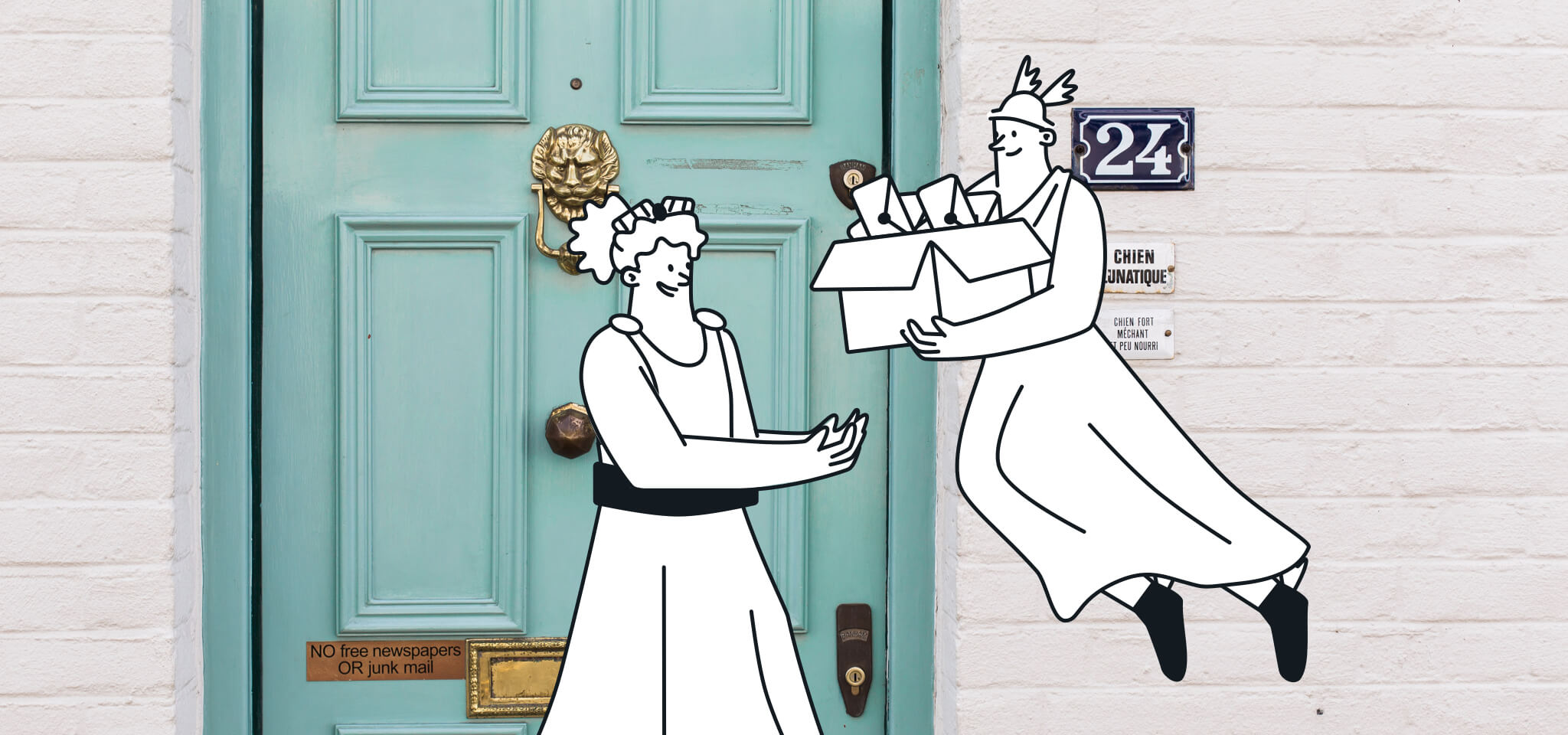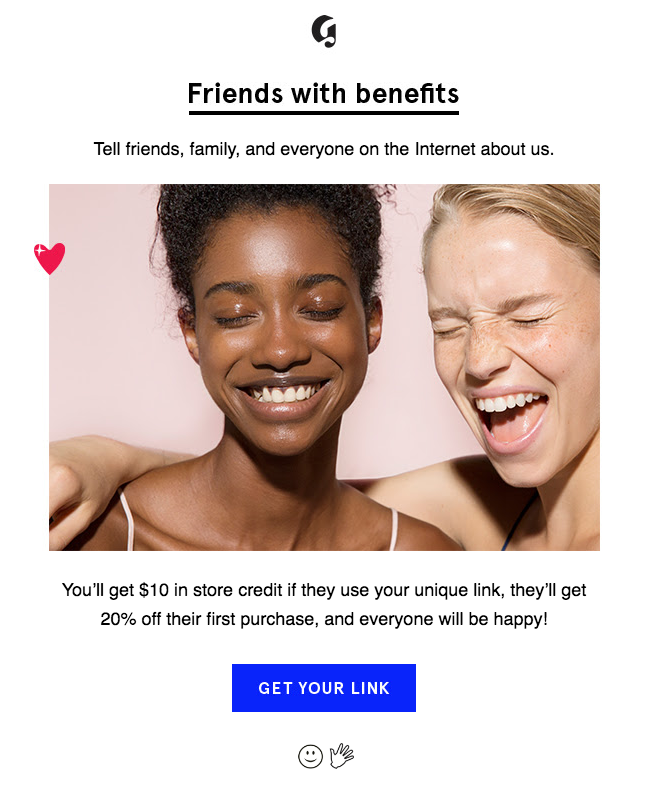Marketing
7 referral marketing strategies to boost sales in 2021
It’s hard to beat the effectiveness of a happy customer referring you to someone else. Learn about the power of referral marketing.

PUBLISHED ON
It’s hard to beat the effectiveness of a happy customer referring you to a colleague, friend, or family member.
Think about it: When a customer refers you to someone in their network, it tells you that you’re offering products that work so well, customers are compelled to share your brand with people they care about.
The data backs this up, too, with 92% of consumers saying that they trust recommendations from friends and family over advertisements. This may also contribute to the weakening effectiveness of traditional marketing strategies – and even influencer marketing – when it comes to converting sales.
With so much information available online, it can be difficult to distinguish an organic review from an advertisement. As a result, people tend to go by the recommendations of people they know and trust.
The power of referrals means that, if you’re not putting a good effort into optimizing a strategic referral program, you’re seriously missing out.
But it’s never too late to reap the benefits. We’ll be laying out seven referral marketing strategies you can apply that will boost your referral results no matter if you’re just starting your program or you’re wanting to refine an existing one. Let’s get started!
Table of contents
1. Win your customers’ trust
2. Double-down on quality
3. Get feedback from your customers
4. Offer two-sided incentives
5. Send emails in moderation
6. Gamify your referral program
7. Use FOMO in your favor
Referral marketing strategies to use in 2021
1. Win your customers’ trust
You can employ all the strategies you can think of for optimizing a referral program, but you won’t get much results unless you win your customer’s trust.
So, how do you do it?
Every interaction your customers have with you is an opportunity for you to earn their trust, even when they’re just taking a quick look at your website.
Privacy Canada wins the trust of their customers by being transparent about why they do what they do. Their mission page features their company ethos – or their “why” – as well as their business model.
Of course, there are many other ways to build trust with your customers. You can offer them products or services they’ll love to share with others. You can make their buyer’s journey as frictionless as possible. You can promise top-notch customer service.
You can even write guest posts for other websites and discuss important topics relevant to your target market. You get referral traffic from this strategy, and you gain customer trust with your demonstrable expertise. To make this work for you, you can acquire the services of a content marketing agency to make the process easier.
One of the best ways to earn customer trust is to show that you know what you’re doing, to do what you do well, and do it consistently.
2. Double-down on quality
As you continue to refine your referral marketing program, you have to make sure you’re offering products or services that are worth a referral.
People don’t want to give bad recommendations. According to marketer Jonah Berger, one of the reasons why people refer something is that it gives them social capital. When they refer to something that makes them look good, it earns them social capital. This is also why if they have a subpar experience with a brand or a product, they are likely to deter their network from making a purchase.
You want to make sure that everyone who encounters your business walks away with a positive experience. When your brand reputation is top-notch, customers trusting you and referring you to others become no-brainers.
You can increase your brand reputation by setting yourself apart. What makes you special? It usually has to do with quality: quality products, quality service, quality customer experience, and so on.
Once you’ve doubled-down on the quality of your offer and your brand reputation, it only makes sense to also double down on the quality of your referral marketing strategies, too. Invest in the technology needed, and in the process optimization.
Make sure your program is painless and seamless for loyal customers to join. If there’s friction in any part of the process, your customers might think the perks and rewards aren’t worth the hassle.
3. Get feedback from your customers
To get your customers to join your referral program, you must make them want what you’re offering as rewards or perks.
Send out a survey asking them for the types of rewards they would like. While there are endless types of rewards and programs you can try, not all of them may make sense for your business.
Asking customers for feedback also gives you an idea of what they want in terms of your offer. It shows them that you’re paying attention, and that you’re always looking for ways to meet their needs.
For example, Freshbooks, an accounting software, released new features that addressed their market’s needs during the pandemic. They’ve added integrations for Shopify and similar tools to help businesses moving from brick-and-mortar shops to eCommerce, and they’re open to feedback and help requests.
If someone who has been hit hard by the pandemic is on the market for accounting software, a Freshbooks customer will likely refer them to the software because the company meets specific needs.
You can also make customer feedback work for you by encouraging users to submit testimonials or post reviews of your product or services right on your website. If you’ve doubled down on quality, then this could be beneficial to you as you’ll likely only receive positive feedback.

Source: Bluetree
Adding testimonies on your sales pages effectively showcases positive feedback from existing customers while building trust to new ones.
Honest reviews by paying customers will be more effective than your sales pages because they don’t have to take your word for it. Instead, they can take the word of your many happy and loyal customers.
4. Offer two-sided incentives
Two-sided incentives give rewards to both the customer making a referral and to the referred customer.
Take the makeup brand, Glossier. They offer two-sided incentives where their loyal customer gets a discount worth up to $10 for every referral that makes a purchase on their website. To make sure the referred prospect actually makes that purchase, Glossier offers them a 20% discount on their first purchase.
Talk about a win-win-win situation.

Source: Pinterest
As referral incentives only need to be paid out after a referred prospect becomes a paying customer, it’s practically risk-free. Any cost you incur from offering rewards are small prices to pay for business growth.
Glossier lays out the terms of their referral program on their website, making it easy for their market to see exactly what they’re going to get, and what they need to do to make a successful referral.
You can even take it a step further and use successful referrals as case studies to put on your website or share on social media as well as subscribers through an email. This could be a good way to advertise your referral program as customers will see how well it works.
5. Send emails in moderation
Just because you have an awesome brand and referral program doesn’t mean all your happy customers will automatically refer you to a friend. They need to see your referral option when they’re most predisposed to tell others about you.
You do this by defining your customer’s triggers. What are the key moments in the customer journey where they see the quality and value of what you’re offering? At which point in the experience have you earned their trust?
Don’t just send out automated emails reminding your customers to leave a review or make a referral. Instead, set up autoresponders based on certain actions or events.
A good place to put referral as your call to action is your transaction emails, like when you notify them that they’ve received the product. You can also encourage a referral after a favorable review of their customer service experience with your company.
6. Gamify your referral program
You can have fun with your referral program.
If you’re trying to expand your reach, you can roll out a rewards points system depending on how many social media platforms a customer posts about your brand.
You can run contests encouraging people to refer friends to your business in exchange for a chance at winning a lucrative prize. You can assign badges for loyal customers with the most number of referrals to gain access to exclusive perks.
Commissions are particularly fun rewards as your customers can gain near-limitless rewards for every referral they make. For example, joining Mailjet’s Referral Program offers a 15% commission on every contract that comes from your referral. Who won’t sign up if the rewards are that lucrative?

7. Use FOMO in your favor
People don’t like missing out on good deals. When you keep this in mind as you craft your referral marketing strategy, you’ll be able to tap into this human behavior.
Offering incentives that have a limit, such as limited slots or limited time offers, gives your visitors a sense of urgency. They think the perks are scarce, so they will act faster.
You can offer free products for the first 100 customers who send a referral your way. You can also host referral periods where perks double if they make referrals within the referral period.
When you’re using the fear of missing out in your favor, make sure you’re communicating this fear across all your marketing channels so that your loyal customers don’t miss it. Put it in a prominent place on your website, send a special email to your subscribers, and share it with an attention-grabbing graphic on your social media profiles.
What to remember
Referral marketing is one of the most powerful marketing strategies in your arsenal because it’s organic and more honest than other direct and sales-y forms of marketing. You can succeed through first winning your customer’s trust by improving the quality of your brand and reputation, and then by listening to their feedback to know exactly what they want and how you can offer it to them.
Make sure you’re tracking your efforts and continuously optimizing your tactics, and you’ll create an amazing, successful referral marketing strategy.
***
This post was written by Kevin Payne, a content marketing consultant helps software companies build marketing funnels and implement content marketing campaigns to increase their inbound leads.








